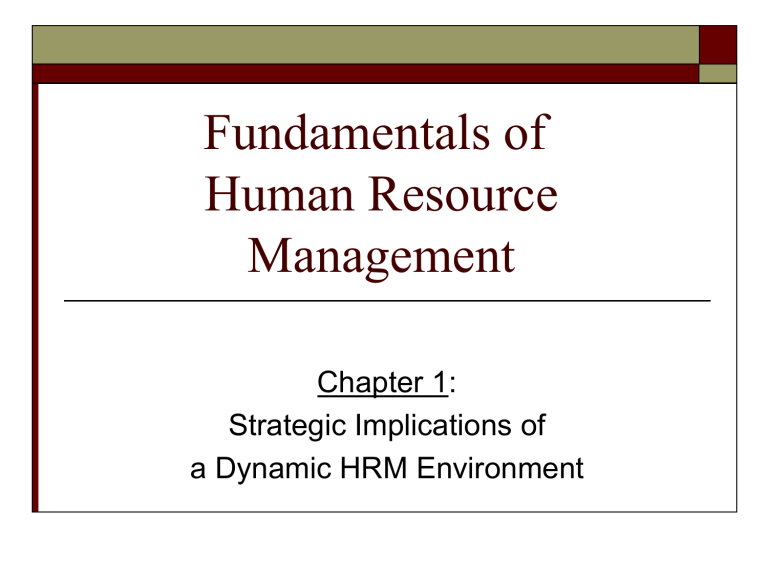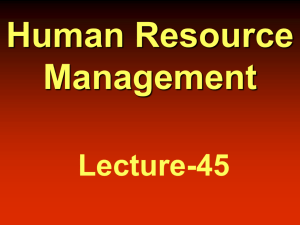
Fundamentals of Human Resource Management Chapter 1: Strategic Implications of a Dynamic HRM Environment The human resource management (HRM) must be prepared to deal with the effects of the changing world of work. This means understanding the implications of globalization, technology changes, workforce diversity, labor shortages, changing skill requirements, continuous improvement initiatives, the contingent workforce, decentralized work sites, and employee involvement. Understanding Cultural Environments The rapidly changing environment organizational members face is the globalization of business. Global village: A concept in which telecommunication and transportation technologies have essentially reduced time and distance effects to produce a single worldwide community. Multinational Corporations (MNCs): Corporations with significant operations in more than one country. Human resources must ensure that employees with appropriate mix of knowledge, skills, and cultural adaptability are available to handle global assignments. Human resource managers need to understand societal issues that might affect operations in another country. As well, HR managers need to understand the laws, values, morals, customs, political and economic systems of different countries, they send their employees to and operate in. Moreover, they must acclimate different groups to each other, finding ways to build teams and thus reduce conflict. The Changing World of Technology Knowledge-work jobs are designed around the acquisition and application of information. Technology: Any equipment, tools, or operating methods, designed to make work more efficient. Technological advances integrate technology into a process of changing input into output. Technological advances make the organizations more productive and help them create and maintain a competitive advantage. Technology has enhanced the production process as well as better servicing to the customers. It also led to the provision of better and more useful information. Technology has changed the way human resource managers work. They can disseminate information more quickly. Members can do their work any place, any time in decentralized work sites. Managers can better facilitate human resources plans, make decisions faster, more clearly define jobs, and strengthen communications with both the external community and employees. It affected recruiting, employee selection, training and development, ethics and employee rights, motivating knowledge workers, paying employees market value, communications, decentralized work sites, skill levels, and the legal concerns. Workforce Diversity Workforce diversity: The varied personnel characteristics that make the workforce heterogeneous. Organizations used to take a “melting-pot” approach to personnel diversity; however, today, employees do not set aside their cultural values and lifestyle preferences when they come to work. The challenge is to make organizations more accommodating to diverse groups of people by addressing different lifestyles, family needs, and work styles. In other words, they are recognizing and celebrating differences. Diversity has caused employers to adapt their human resource practices to reflect those changes. The Labor Supply Downsizing: An activity in an organization aimed at creating greater efficiency by eliminating certain jobs. Outsourcing: Sending work “outside” the organization to be done by individuals not employed full time with the organization. Contingent workforce: The part-time, temporary, and contract workers used by organizations to fill peak staffing needs or perform work not done by core employees. From the human resource manager perspective, each contingent worker may need to be treated differently in terms of practices and policies. Human resource managers must make sure that contingent workers do not perceive themselves as a second-class workers. Human resource managers must motivate the entire workforce -full-time and temporary employees- and to build their commitment to doing good work. HR managers confront HRM issues as having these “virtual” employees available when needed, providing scheduling options that meet their needs, and making decisions about whether benefits will be offered to the contingent workforce. HR managers must also give a thought of how to attract quality temporaries, orient, pay and benefit them. They also must be prepared to deal with conflicts between core and contingent workers. Continuous Improvement Programs Quality management: Organizational commitment to continuous process of improvement that expands the definition of customer to include everyone involved in the organization. Continuous improvement: Organizational commitment to constantly improving the quality of products or services (the Japanese term is kaizen). Work process engineering: Radical and quantum change in an organization. HRM must prepare individuals to change and help affected ones to overcome barriers to change. HRM must train employees in these new processes and help them attain new skill levels that may be associated with the “new, improved” operations. Employee Involvement This includes delegation, participative management, work teams, goal setting, employer training, and empowering of employees. Useful employee involvement requires demonstrated leadership, as well as supportive management. Additionally, employees need training. Workers need to understand new job designs processes. A Look at Ethics Ethics: A set of rules or principles that defines right and wrong conduct. Right and wrong behavior is difficult to determine. A code of ethics: A formal document that states an organization’s primary values and the ethical rules it expects organizational members to follow.

